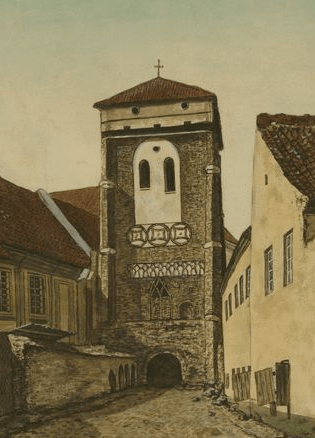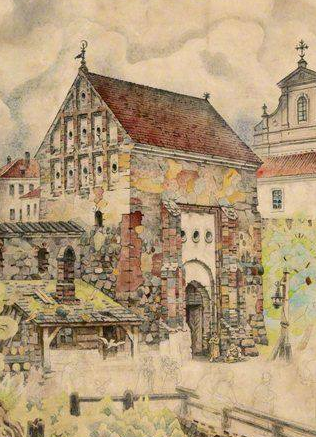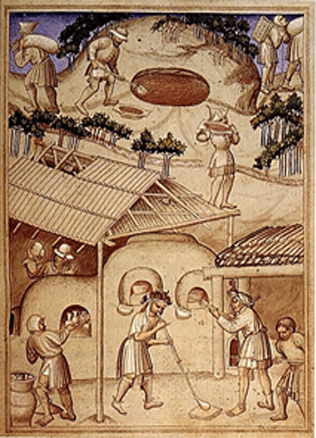How a Royal Guard Gunned Down a Cuckoo with His Musket
The court was the environment where rulers spent most of their life. A particular building where the ruler would stay or live was not the most important part of his court, as of the institution. The court, a duplicate of the ruler in a sense, embodied his majesty (maiestas) everywhere and every time, even when the ruler himself was not there. The ruler had almost no private life, while his private environment was limited to several rooms within the residence. Outside his private chambers, the ruler was a public person who had to adhere to the commonly accepted rules of courtly life. He was able to influence or change them but could not deny them altogether.
Escorts and guards, the cream of the court hierarchy
All rulers of Lithuania had smaller or larger courts. Very little is known about the courts of the first rulers. Historians have more information concerning the courts of Vytautas, Sigismund I the Old and especially Sigismund I August (1520–1572, reigned 1544–1572). Sigismund I August’s court began taking shape in 1537, when he reached adolescence, and survived up until his death in 1572. His court followed the old tradition, while in terms of structure it was similar to the court of his father, Sigismund I the Old. The court of the king of Poland and the Grand Duke of Lithuania had a clear hierarchical structure lead by the ruler’s courtiers (aulici). Accompanying the ruler during travel and various public appearances was their most important duty. In other words, they acted partly as his bodyguards and added solemnity and solidity to the ruler’s escort.
Marshal was the top official of the court.
Treasurer was second in the list of ranks. Head of chambers (subcamerarius) took care about the ruler’s private rooms, as well as of his attire. In addition to that, he supervised all chamber servants of the ruler. A stableman was in charge of stables.
Guards (stipatores) followed courtiers in the list of court officials working for a salary. Ensuring personal security of the ruler and general order within the court was their principal task. Guards sported exceptional attire and armament. They carried halberds, their main distinguishing feature. Some sources indicate that they also had harquebuses. The ruler’s treasury supplied them with fabrics for their clothes. Everyday clothing was made from the English baize, while the Mischinensis baize was used for travel clothing. Spruce overcoats were made of nankeen or Czech baize, sztamat (a type of woollen fabric) was used to sew trousers, special caps (berets) were made of velvet. Every guard earned 20 florins a year in salary, five florins every quarter. In addition to that, they would receive one florin each week to buy food. Every guard had one personal servant in his disposition.
Chamber servants were closest to the ruler
The ruler’s room service was another important group of court officials. It included chamber servants, pages, lackeys, clothing supervisors, door attendants, and even dwarfs. Chamber servants were ranked highest among them. Chamber servants and pages, or minor room attendants, served the ruler when he was inside the apartments of his residence.
They also acted as intermediates by conveying oral orders and instructions of the ruler to other courtiers.
Chamber servants often travelled within the country as their ruler’s envoys. The fabrics that chamber servants and pages would receive from the treasury for their clothing included, depending on their stature, three to four cubits of English baize, 1–1¼ cubits of sztamat for trousers and socks, nine (for chamber servants) and five or six (for pages) cubits of Mischinensis baize for travel clothes, 4¼–5¾ cubits of black damask for a župica, four cubits of futerbarkan, three or four cubits of Krosno baize for the lining of the župica, 2½ quartes of velvet for caps, and several pieces of chamois leather for boots and overcoat. Couriers represented a separate group of court officials. They were in charge of delivering the ruler’s correspondence to addressees and bringing back letters to the ruler.
The kitchen was in charge of feeding the ruler and his court. The kitchen was a big organisation that employed a number of waged people, including chief cooks, junior cooks (apprentices), a baker, a deliverer of products, and an attendant of kitchen door. Doctors, pharmacists, barbers, steam bath supervisors and laundresses took care about the ruler’s health and cleanness. Stables were one of the most important parts of the court, because a horse and a horse-drawn cart were the two main means of land transport at the time. For instance, Sigismund II August had 396 horses in his stables in 1543, right after his arrival in Lithuania, including 167 horses for harness and another 219 for riding. Meanwhile, in the middle of November 1544, when his court had already moved to Vilnius, the number of horses went up to 480.
The unconventional way of earning king’s favour
The ruler’s court housed plenty of people of various ranks. The court was the place where envoys of foreign rulers would pay their respect and where knight tournaments and acrobat performances would take place. It was there that several-day hunt outings, usually around the residential castle, used to be arranged. The castle was the scene of various exotic events too. Here is what happened to Sigismund II August in 1546 in Vilnius. His book of expenditures includes the following message: “A guard named Konarski, who delivered a cuckoo shot from a musket in spring, was given 5¾ cubits [of damask fabric] as a grace of his royal majesty.” The message, insignificant in its nature, conceals great interest and appraisal shown by the ruler.
We have all heard cuckoo’s voice, but has anyone ever seen it?
It is not likely, because cuckoo is an elusive bird that usually tries to stay out of the human sight. Attempting to shoot it from a musket, a weapon far from perfect in the middle of the 16th century, might have proved quite a task! That was why the ruler rewarded the guard who had brought him the “trophy” with the annual allowance of damask, a specific kind of black silk. The guard was granted a grace or, in today’s terms, a premium for his professional achievements. Another question is whether he really did his job properly if he had time to run after cuckoos in the forest? History provides no answer to that.
Literature: Lietuvos didžiojo kunigaikščio Žygimanto Augusto dvaro sąskaitos (1543–1548). 1544 XI 15–1546 XI 15. 1 knyga, parengė D. Antanavičius, vertė S. Narbutas, Vilnius, 2009, p. 164–165.
Darius Antanavičius



